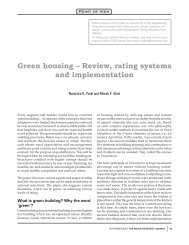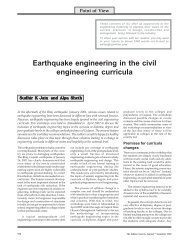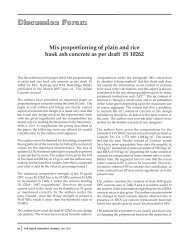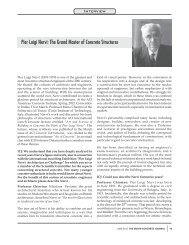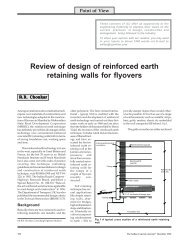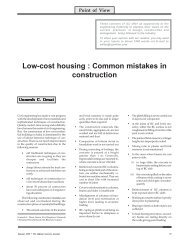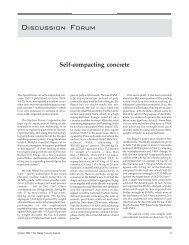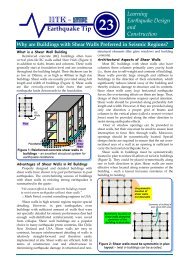Download - The Indian Concrete Journal
Download - The Indian Concrete Journal
Download - The Indian Concrete Journal
You also want an ePaper? Increase the reach of your titles
YUMPU automatically turns print PDFs into web optimized ePapers that Google loves.
Point of View<br />
<strong>The</strong>se columns of ICJ offer an opportunity to the<br />
engineering fraternity to express their views on the<br />
current practices in design, construction and<br />
management being followed in the industry.<br />
To share your opinion with our readers, you may<br />
send in your inputs in about 1500 words via e-mail<br />
to editor@icjonline.com<br />
Are existing IS codes suitable for<br />
engineering of HVFAC?<br />
P.C. Basu and S. Saraswati<br />
Tracing back the history of the<br />
development of concrete, compressive<br />
strength was being considered as the<br />
most important parameter to classify<br />
this material since its inception. Even,<br />
in order to produce durable concrete,<br />
grade of concrete was generally<br />
increased, based on the perception that<br />
there was a direct relation between the<br />
strength of concrete and durability. It<br />
has been realised with experience that<br />
strength is not the only important<br />
parameter, other attributes such as<br />
durability and workability of concrete<br />
are also important for successful<br />
engineering of concrete structures.<br />
<strong>The</strong>re are a number of cases of<br />
premature failure of concrete structures<br />
due to inadequate durability though<br />
concrete strength was high. This has led<br />
to the concept of developing high<br />
performance concrete (HPC). HPC is a<br />
concrete which is engineered to satisfy<br />
the criteria proposed to overcome the<br />
limitations of control concrete or normal<br />
strength concrete (NSC), in order to<br />
meet the requirements specific to its<br />
intended use. High volume fly ash<br />
concrete (HVFAC) is a type of HPC in<br />
which fly ash is used in higher quantity<br />
as supplementary cementitious material<br />
partially replacing Ordinary Portland<br />
Cement (OPC).<br />
<strong>Concrete</strong>, be it NSC or HVFAC, is<br />
principally a three phase composite<br />
material consisting of a binding media<br />
within which particles or fragments of<br />
aggregates are embedded 1 . <strong>The</strong>se three<br />
phases are bulk hydrated cement paste<br />
(HCP), aggregates and transition zone<br />
between bulk HCP and aggregate. <strong>The</strong><br />
transition zone, also HCP but of inferior<br />
quality than that of bulk HCP, is the<br />
weakest phase from strength as well as<br />
durability point of view. It mainly<br />
consists of bulk quantity of calcium<br />
hydroxide crystal, voids, pores,<br />
microcracks, and water is present in<br />
plenty in this phase of microstructure.<br />
Improved properties of any concrete<br />
composite is achieved by modifying the<br />
microstructure, particularly that of<br />
transition zone by using chemical or<br />
mineral admixtures having pozzolanic<br />
characteristics. <strong>The</strong> mechanism which<br />
leads to the desired modification of the<br />
microstructure has three components 2 ,<br />
(i) reaction mechanism among<br />
ingredients,<br />
(ii) physical process, and<br />
(iii) curing.<br />
Reaction mechanism is basically<br />
related to chemical reaction among<br />
ingredients and related physical<br />
phenomena. Physical process, deals<br />
with different construction activities —<br />
production of fresh concrete,<br />
transportation and placement. Curing<br />
maintains the satisfactory condition so<br />
that reaction mechanism can be<br />
completed to a desirable state by<br />
preventing moisture loss and<br />
maintaining appropriate temperature<br />
during the process of hydration.<br />
Fly ash is a fine-grained pozzolanic<br />
material, generally spherical in shape.<br />
Scanning electron microscope (SEM)<br />
images reveal that fly ash consists of<br />
either solid and/or hollow spheres. It<br />
is most probably the best mineral<br />
admixture to be used as supplementary<br />
cementitious material in concrete. In<br />
HVFAC, cement replacement level by<br />
fly ash is 50 percent or more and waterbinder<br />
(cement plus fly ash) ratio is not<br />
more than 0.4.<br />
From the consideration of reaction<br />
mechanism, the reactive silica of fly ash<br />
August 2006 * <strong>The</strong> <strong>Indian</strong> <strong>Concrete</strong> <strong>Journal</strong> 17
produces C-S-H gel after reacting with<br />
CH crystal generated from the primary<br />
hydration of OPC. In addition,<br />
unhydrated fly ash particles act as filler<br />
material in the microstructure. Such<br />
pozzolanic action causes improved<br />
microstructure of concrete composite,<br />
especially in transition zone by<br />
eliminating CH crystals, reducing voids<br />
and refining both grains and pores. All<br />
these result in concrete of higher<br />
performance (better rheology, strength<br />
and durability), preservation of<br />
resources (saving in limestone, coal and<br />
energy used in the production of OPC<br />
clinker). <strong>The</strong> material, HVFAC, is also<br />
environmental friendly as it is a highly<br />
productive and effective method of<br />
disposing fly ash in eco-friendly way<br />
and also reduce greenhouse gas<br />
emissions associated with<br />
manufacturing of OPC. In view of this,<br />
fly ash is also considered as resource<br />
material for sustainable development of<br />
a country like India 3 .<br />
Characterisation of materials to<br />
ensure proper quality of ingredient and<br />
their appropriate proportioning in the<br />
mix has strong impact on the reaction<br />
mechanism in developing HVFAC mix.<br />
Physical process, such as mixing<br />
method (manufacturing process),<br />
transportation and placement result in<br />
creating conducive conditions for<br />
reaction mechanism to take place<br />
appropriately for imparting the desired<br />
attributes of the mix. HVFAC mix needs<br />
to be cured adequately. Another<br />
important aspect is acceptance criteria.<br />
All these activities related to<br />
construction using HVFAC should be<br />
undertaken following well established<br />
specifications which are generally based<br />
on the codes and practice of the country.<br />
Are <strong>Indian</strong> Standard (IS) codes good<br />
enough for prescribing the requisite<br />
specification for engineering concrete<br />
structures using HVFAC? <strong>The</strong> objective<br />
of the present article is to assess the<br />
suitability of the existing IS codes<br />
having a bearing on fly ash concrete,<br />
especially HVFAC.<br />
<strong>The</strong> ingredients for HVFAC are<br />
binder (OPC and fly ash), aggregates<br />
(coarse and fine), and water along with<br />
superplasticiser. Relevant IS codes of<br />
practice for specification of aggregates,<br />
water and superplasticiser have been<br />
successfully used over a long period for<br />
proportioning and producing<br />
18<br />
Point of View<br />
acceptable concrete mixes without<br />
mineral admixtures. <strong>The</strong>se standards<br />
were also successfully used in the recent<br />
past in developing high performance<br />
concrete incorporating silica fume and<br />
high reactivity metakaolin 4,5 .<br />
Transportation and placement of any<br />
concrete mix is related to rheology and<br />
workability of the mix. Mix<br />
proportioning has great influence on<br />
these two attributes of concrete mix at<br />
fresh state. Time for striking of<br />
shuttering is dependent on the strength<br />
gain of the mix after placement, which<br />
is again dependent on the mix<br />
proportion. In view of this, only those<br />
IS codes relevant to characterisation of<br />
fly ash, proportioning of HVFAC mixes<br />
and its acceptance criteria, mixing<br />
method and curing are deliberated<br />
below in the light of the findings of<br />
experimental studies presented in<br />
literature 3,6,7,8,9,10 .<br />
Characterisation of fly ash<br />
As per IS 3812 : 2003 , the generic name<br />
of the waste product due to burning of<br />
coal or lignite in the boiler of a thermal<br />
power plant is pulverised fuel ash<br />
(PFA) 11,12 . PFA can be fly ash, bottom<br />
ash, pond ash or mound ash. ‘Fly Ash’<br />
is the pulverised fuel ash extracted from<br />
the flue gases by any suitable process<br />
like cyclone separation or electrostatic<br />
precipitation. PFA collected from the<br />
bottom of boilers by any suitable<br />
process is termed as ‘Bottom Ash’. <strong>The</strong><br />
terminology ‘Pond Ash’ is used when<br />
fly ash or bottom ash or both mixed in<br />
any proportion is conveyed in the form<br />
of water slurry is deposited in pond or<br />
lagoon. When fly ash or bottom ash or<br />
mixture of these in any proportion is<br />
conveyed or carried in dry form and<br />
deposited dry, it is known as ‘Mound<br />
Ash’. Use of fly ash as mineral<br />
admixture in structural concrete is<br />
acceptable as per IS 456 13 . However, the<br />
second revision of IS 3812 : 2003<br />
encourages use of any type of PFA, in<br />
concrete provided it satisfies the<br />
requirements of the code 11,12 . Otherwise,<br />
the ash is to be processed.<br />
IS 3812 : 2003 categorises fly ash into<br />
two types, namely, siliceous fly ash<br />
(SFA) having reactive calcium oxide<br />
content less than 10 percent and<br />
calcareous fly ash (CFA) having reactive<br />
calcium oxide content generally<br />
between 10 percent to 25 percent 11,12 .<br />
SFA type of fly ash is more suitable for<br />
HVFAC. ASTM C618-03 defines fly ash<br />
as finely divided residue resulting from<br />
the combustion of ground and<br />
powdered coal and transported by flue<br />
gas 14 . ASTM C 618-03 categorises fly<br />
ash into two classes; class F and class<br />
C, which are equivalent to SFA and<br />
CFA, respectively of IS 3812 : 2003.<br />
Canadian code also defines fly ash in a<br />
similar way as that of ASTM C618-03.<br />
Results presented in reference 3<br />
indicate that <strong>Indian</strong> fly ash possesses all<br />
the requisite characteristics needed for<br />
producing HVFAC of acceptable<br />
quality. <strong>The</strong> independent work of<br />
Fournier et al and Sivasundaram<br />
confirms this 6,7 . Bureau of <strong>Indian</strong><br />
Standards (BIS) has published the<br />
specifications of pulverised fuel ash,<br />
IS 3812 : 2003 in two parts,<br />
• Part-1: for use as pozzolana in<br />
cement, cement mortar and<br />
concrete<br />
• Part-II: for use as admixture in<br />
cement mortar and concrete.<br />
Both the parts of the code define fly<br />
ash as a special class of PFA. This code<br />
can be adopted for characterisation<br />
depending on its use as pozzolana or<br />
mineral admixture. However, the<br />
terminologies, pozzolana and mineral<br />
admixture, are sometimes ambiguously<br />
used as synonymous to each other. It is<br />
important to clearly understand the<br />
difference between these two types of<br />
usage, as there exist certain variations<br />
in specification given in the two parts<br />
of IS 3812 : 2003.<br />
As per ASTM C125-02, admixture is<br />
a material other than water, aggregates,<br />
hydraulic cementitious material, and<br />
fibre reinforcement that is used as an<br />
ingredient of a cementitious mix to<br />
modify its freshly mixed, setting or<br />
hardened properties and which is<br />
added to the batch before or during its<br />
mixing 15 . Chemical admixtures like<br />
superplasticiser are water-soluble. <strong>The</strong><br />
term mineral admixture has been used<br />
to refer to different types of water<br />
insoluble, finely divided materials such<br />
as pozzolanic materials, cementitious<br />
materials and aggregate. <strong>The</strong>se<br />
materials are not similar and it is not<br />
correct to group them under a single<br />
term. <strong>The</strong> name of the specific material<br />
should be used; for example, use<br />
<strong>The</strong> <strong>Indian</strong> <strong>Concrete</strong> <strong>Journal</strong> * August 2006
‘pozzolan’ as is appropriate. Pozzolan<br />
is siliceous or siliceous and aluminous<br />
material, which itself possesses little or<br />
no cementitious value but will, in finely<br />
divided form and in the presence of<br />
moisture, chemically react with calcium<br />
hydroxide at ordinary temperatures to<br />
form compounds possessing<br />
cementious properties.<br />
Mineral admixtures may be reactive<br />
or inactive in terms of cement<br />
hydration. Pozzolans or cementitious<br />
materials are reactive mineral<br />
admixtures, while finely divided<br />
aggregates are inactive. IS 3812 : 2003<br />
allows the use of fly ash in concrete both<br />
as pozzolana (Part-I) and mineral<br />
admixture (Part-II). Both the parts of<br />
IS 3812 : 2003 specify detailed<br />
requirements on physical and chemical<br />
characteristics of fly ash. Amongst<br />
these, two requirements, the one on loss<br />
of ignition and the other one on the<br />
fineness are important. Requirement on<br />
LOI has significant bearing on<br />
durability, higher LOI could impede<br />
durability. <strong>The</strong>refore, strict adherence<br />
to the requirement of LOI (5 percent) is<br />
very important. Fineness has influence<br />
on improving strength and also<br />
durability.<br />
IS 3812 : 2003 specifies 34 percent<br />
retention of particles coarser than 45 μ<br />
in case of fly ash used as pozzolanic<br />
material (Part-I) and 50 percent<br />
retention for its use as mineral<br />
admixture (Part-II). Additionally, the<br />
standard also specifies the average<br />
fineness requirement as 320 m 2 /kg for<br />
the use as pozzolana (Part – I) and<br />
200 m 2 /kg for admixture. Contribution<br />
of particles coarser than 45 μ to<br />
secondary hydration by means of<br />
pozzolanic reaction is not significant.<br />
<strong>The</strong>ir incorporation in concrete mix may<br />
be viewed as replacement of sand.<br />
<strong>The</strong>refore, particle size of 45 μ or less is<br />
more important for pozzolanic action<br />
than the average fineness of fly ash.<br />
ASTM C618-03 and Japanese code JISA<br />
6201-99 do not specify the requirement<br />
on average fineness 13,16 . This<br />
requirement should be deleted from IS<br />
3812 : 2003, otherwise it may create<br />
confusion.<br />
Mix proportioning<br />
<strong>The</strong>re is a school of thought which<br />
subscribes to the view that IS codes do<br />
Point of View<br />
not allow more than 35 percent of fly<br />
ash in concrete. No IS code limits the<br />
quantity of fly ash to be used either as<br />
pozzolana or mineral admixture for<br />
replacement of OPC in proportioning<br />
the mix for structural concrete.<br />
However, IS 1489 (Part I) : 1991 specifies<br />
35 percent as the upper limit of fly ash<br />
for blended cement, (Portland<br />
pozzolanic cement) 17 . <strong>The</strong> confusion<br />
might have originated from the footnote<br />
of Table 5 of IS 456 13 . <strong>The</strong> first footnote<br />
of the table states,<br />
“Cement content prescribed in<br />
this table is irrespective of the<br />
grades of cement and it is<br />
inclusive of additions mentioned<br />
in 5.2. <strong>The</strong> additions such as fly<br />
ash or ground granulated blast<br />
furnace slag may be taken into<br />
account in the concrete<br />
composition with respect to the<br />
cement content and water –<br />
cement ratio if the suitability is<br />
established and as long as the<br />
maximum amounts taken into<br />
account do not exceed the limit<br />
of pozzolana and slag specified<br />
in IS 1489 (Part-I) and IS 455,<br />
respectively” 17 .<br />
Intent of the footnote is only related<br />
to determination of the minimum<br />
cement content, maximum watercement<br />
ratio and minimum grade of<br />
concrete for different exposures with<br />
normal weight aggregates of 20 mm<br />
nominal maximum size. As per this<br />
footnote, contribution of fly ash should<br />
not be taken more than 35 percent of the<br />
total cement content (binder: OPC + fly<br />
ash) in calculating the minimum cement<br />
content when CRL by fly ash is more<br />
than 35 percent. For example, in case of<br />
severe exposure condition, minimum<br />
grade of concrete and corresponding<br />
minimum cement content specified in<br />
Table 5, IS 456 is M30 and 320 kg/m 3 ,<br />
respectively 13 . If HVFAC mix is to be<br />
proportioned with CRL of 50 percent by<br />
fly ash, then binder (OPC + fly ash)<br />
content of 377.00 kg/m 3 is required to<br />
satisfy the minimum requirement of 320<br />
kg/m 3 cement (OPC: 0.5 x 377.00 + fly<br />
ash: 0.35 x 377.0).<br />
Another important aspect<br />
associated with mix<br />
proportioning is fixation of<br />
target strength. In this context,<br />
clause 4.9.2.2 of IS 456 specifies<br />
the following 15 :<br />
“<strong>The</strong> mix shall be designed to<br />
produce the grade of concrete having<br />
the required workability and<br />
characteristic strength not less than<br />
appropriate values given in Table 2. <strong>The</strong><br />
target mean strength of concrete mix<br />
should be equal to the characteristic<br />
strength plus 1.65 times the standard<br />
deviation”. 13<br />
Requirement of the first part is<br />
related to the acceptance criteria and<br />
needs to be adhered to for all types of<br />
concrete mix whether it is produced by<br />
hand mixing or through highly<br />
mechanised batching plant having<br />
high-speed mixer. <strong>The</strong> second part is<br />
desirable if hand mixing or other means<br />
is resorted to for production of concrete<br />
where higher uncertainties exist in<br />
achieving at site the same properties as<br />
determined at laboratory from trial<br />
mixes. But, this requirement is<br />
completely unnecessary when batching<br />
plant with high-speed mixer at site or<br />
ready mix concrete (RMC) is used.<br />
Canadian code A23.1-04 does not<br />
specify such requirements 18 . Experience<br />
shows concrete mix produced by highspeed<br />
mixer exhibit better properties<br />
than that of trial mixes conducted at<br />
laboratory. Application of this clause,<br />
irrespective of production mode would<br />
result in unnecessary use of higher<br />
quantity of OPC, which is not conducive<br />
for sustainable development of a<br />
country like India. <strong>The</strong> requirement of<br />
target strength shall not be considered<br />
as mandatory; mandatory requirement<br />
is the acceptance criteria.<br />
HVFAC concrete shall always be<br />
produced in plant using mechanised<br />
mixer having weight batcher and not by<br />
hand mixing. <strong>The</strong> target strength for<br />
proportioning HVFAC need not be<br />
equal to the characteristic strength plus<br />
1.65 times standard deviation. HVFAC<br />
is not expected to be economical for mix<br />
leaner than M30 and the target strength,<br />
if necessary for convenience of<br />
developing mix proportion, could be<br />
conservatively set at the value of 1.2<br />
times the characteristic strength.<br />
Mixing method<br />
Manufacturing process of concrete mix<br />
involves stages of mixing (single stage<br />
August 2006 * <strong>The</strong> <strong>Indian</strong> <strong>Concrete</strong> <strong>Journal</strong> 19
or multistage) and agitation time in each<br />
stage. <strong>The</strong>re are no IS codes which<br />
specify guidelines on the mixing<br />
method for concrete and hardly any<br />
published specification is available on<br />
this subject. However, research work<br />
indicates that mixing method has<br />
influence on the properties of concrete<br />
mixes including HVFAC mix 19 .<br />
<strong>The</strong>refore, selection of appropriate<br />
mixing method is important for optimal<br />
utilisation of HVFAC.<br />
<strong>The</strong> acceptance criteria of any<br />
concrete mix is specified in terms of 28<br />
days cube compressive strength, refer<br />
Table 11 of IS 456. It is seen from the<br />
results mentioned in references and<br />
those results published in different<br />
literature that gain in strength and<br />
reduction in rapid chloride permeability<br />
test (RCPT) value of fly ash concrete<br />
from the age of 28 days to 56 days and<br />
beyond are substantial 3,6,7,8,9,10 .<br />
Moreover, no structure or structural<br />
component is subject to designed<br />
service condition at the age of 28 days.<br />
<strong>The</strong>refore, acceptance criteria based on<br />
28 days would lead to non-utilisation<br />
of all advantages of HVFAC. It is<br />
suggested to define the acceptance<br />
criteria based on 56 days properties or<br />
more. Canadian code A23.1-04 has<br />
already specified such acceptance<br />
criteria 18 . However, every care is to be<br />
taken to ensure that the mix gains<br />
requisite strength to withstand the effect<br />
of construction activities after the<br />
minimum period necessary for curing,<br />
that is, 14 days or after stripping of<br />
shuttering, whichever is earlier.<br />
Curing<br />
HVFAC mix has low w/b ratio that<br />
causes less bleeding resulting in<br />
potential risk of plastic shrinkage cracks<br />
if curing is not started as early as<br />
possible. This calls for initial curing,<br />
which should be started immediately<br />
after placing of concrete. No IS codes<br />
covers specification of initial curing and<br />
reference – 20 addresses initial curing<br />
of silica fume incorporated HPC in<br />
detail. Approaches suggested there<br />
have been found suitable for HVFAC.<br />
Covering surfaces with impervious<br />
sheet or applying curing compounds as<br />
in the case for concrete pavements are<br />
efficient methods for initial curing.<br />
After final setting of concrete, water<br />
20<br />
Point of View<br />
curing should be commenced.<br />
Specification of IS 456 is sufficient for<br />
this purpose 13 .<br />
Conclusion<br />
Based on the above discusion, following<br />
conclusions can be drawn.<br />
(i) Existing IS codes are suitable for<br />
characterisation of concrete<br />
ingredients for HVFAC. Major<br />
observations on IS 3812 (Part - I and<br />
II) : 2003 specifications for<br />
characterisation of fly ash are,<br />
(a) <strong>The</strong> standard specifies<br />
suitable requirements for<br />
characterisation of fly ash.<br />
Requirement mentioned about<br />
average fineness is not<br />
necessary and may be deleted.<br />
(b) Most important requirement<br />
for characterisation of fly ash<br />
is to restrain the LOI to 5<br />
percent.<br />
(ii) IS codes impose limitation of 35<br />
percent on the maximum usage of<br />
fly ash in Portland pozzolana<br />
cement but there exists no<br />
limitation on the quantity of fly ash<br />
in concrete mix, if it is mixed<br />
separately in site batching.<br />
(iii) HVFAC should be produced in<br />
mechanised batching plant or RMC<br />
plant under necessary quality<br />
control. Target strength for<br />
developing HVFAC or any<br />
concrete mix produced by<br />
mechanised mixer need not be<br />
fixed at characteristic strength plus<br />
1.65 times standard deviation. A<br />
conservative estimate of target<br />
strength is 1.2 times the<br />
characteristic strength for mix not<br />
leaner than grade M30.<br />
(iv) From the point of view of economy,<br />
HVFAC should be characterised<br />
for 56-day strength. However, the<br />
mix should have required strength<br />
for construction purpose after the<br />
minimum period required for<br />
curing, that is, 14 days.<br />
(v) Neither IS code nor codes of any<br />
other country provides guidelines<br />
on mixing method of HVFAC.<br />
Published work on this subject<br />
suggests mixing method has<br />
influence on the performance of<br />
HVFAC and other types of concrete<br />
mixes.<br />
(vi) HVFAC should be cured in two<br />
stages. Initial curing is dry curing<br />
for which no specification is<br />
available in any IS code. However,<br />
specification of IS 456 on wet<br />
curing is adequate.<br />
References<br />
1. MEHTA, P.K. and MONTEIRO, P.J.M., <strong>Concrete</strong> –<br />
Microstructure, Properties and Materials, First<br />
international edition, <strong>Indian</strong> <strong>Concrete</strong> Institute,<br />
1997.<br />
2. BASU, PRABIR C., High performance concrete:<br />
mechanism and application, ICI <strong>Journal</strong>, April-<br />
June 2001, Vol. 2, No. 1, <strong>Indian</strong> <strong>Concrete</strong><br />
Institute, pp. 15-26.<br />
3. BASU, PRABIR C., SARASWATI, SUBHOJIT, High<br />
volume fly ash concrete with <strong>Indian</strong><br />
ingredients, <strong>The</strong> <strong>Indian</strong> <strong>Concrete</strong> <strong>Journal</strong>,<br />
March 2006, Vol. 80, No. 3, pp. 37-48<br />
4. BASU, PRABIR C., NPP Containment Structures:<br />
<strong>Indian</strong> Experience in Silica Fume Based HPC,<br />
<strong>The</strong> <strong>Indian</strong> <strong>Concrete</strong> <strong>Journal</strong>, October 2001,<br />
Vol. 75, No.10, pp. 656-664.<br />
5. MAVINKURVE, SHREETI, BASU, PRABIR, C. and<br />
KULKARNI, V.R., High performance concrete<br />
using high reactivity metakaolin, <strong>The</strong> <strong>Indian</strong><br />
<strong>Concrete</strong> <strong>Journal</strong>, May 2003, Vol. 77, No. 5, pp.<br />
1077-1085.<br />
6. FOURNIER, B., LU., D., CHARLAND, J.P. and LI, J.,<br />
Evaluation of <strong>Indian</strong> fly ashes for use in HVFA<br />
<strong>Concrete</strong>s - Part I: Characterisation, <strong>The</strong> <strong>Indian</strong><br />
<strong>Concrete</strong> <strong>Journal</strong>, November 2004, Vol. 78,<br />
No. 11, pp. 22-30.<br />
7. SIVASUNDARAM, V., Evaluation of <strong>Indian</strong> fly<br />
ashes for the HVFA concrete - Part II:<br />
Behaviour in <strong>Concrete</strong>, <strong>The</strong> <strong>Indian</strong> <strong>Concrete</strong><br />
<strong>Journal</strong>, November 2004, Vol. 78, No. 11, pp.<br />
41-50.<br />
8. DESAI, J., Construction of HVFA concrete<br />
pavements in India: Four case studies, <strong>The</strong><br />
<strong>Indian</strong> <strong>Concrete</strong> <strong>Journal</strong>, November 2004, Vol. 78,<br />
No. 11, pp. 67-71.<br />
9. ASHRAF, M., SHARMA, AMIT and MOKAL, MANISH,<br />
HVFA <strong>Concrete</strong> for tremie seal and pylon pile<br />
cap of Bandra-Worli sea link project, <strong>The</strong> <strong>Indian</strong><br />
<strong>Concrete</strong> <strong>Journal</strong>, November 2004, Vol. 78,<br />
No. 11, pp. 31-36.<br />
10. SHETTY, M.S., SEETHARAMAIAH, R.V., REDDY, S.A.,<br />
PAI, B.V.B. and KAUSHIK, S.K. High strength<br />
cement – State of the art report, International<br />
Symposium on Innovative World of <strong>Concrete</strong>,<br />
Bangalore, India, 1993.<br />
11. ______Pulverised fuel ash – specification, Part-1:<br />
for use as pozzolana in cement, cement mortar and<br />
concrete, IS 3812 (Part 1) : 2003, Bureau of <strong>Indian</strong><br />
Standards, New Delhi, India.<br />
12. ______Pulverised fuel ash – specification, Part-2:<br />
for use as admixture in cement, mortar and concrete,<br />
IS 3812 (Part 2): 2003, Bureau of <strong>Indian</strong><br />
Standards, New Delhi, India.<br />
<strong>The</strong> <strong>Indian</strong> <strong>Concrete</strong> <strong>Journal</strong> * August 2006
13. ______<strong>Indian</strong> standards: plain and reinforced<br />
concrete – Code of practice, IS 456, 4 th revision,<br />
September 2000, Bureau of <strong>Indian</strong> Standards,<br />
New Delhi, India.<br />
14. ______Standard specification for coal fly-ash and<br />
raw or calcined natural pozzolan for use in concrete,<br />
ASTM C 618-03.<br />
15. ______Standard terminology relating to concrete<br />
and aggregates, ASTM C125-02.<br />
16. NAGATAKI, S., TOMOSAWA, F., KANAZU., T. and<br />
YAMAMOTO, T., Classification of Fly-ash<br />
according to Japan Industiral Standard, JISA<br />
6201-1999, Seventh CANMET/ACI International<br />
conference on Fly-ash, Silica Fume, Slag and<br />
Natural Pozzolanas in <strong>Concrete</strong>, ACI SP 199,<br />
Vol. 1, pp. 29-42, Chennai, 2001.<br />
17. ______Specification for portland pozzolana cement<br />
: Part 1 fly ash based, IS 1489 (Part I) : 1991,<br />
Bureau of <strong>Indian</strong> Standards, New Delhi.<br />
18. ______<strong>Concrete</strong> materials and methods for concrete<br />
construction, A23.1-04, Canadian Standards<br />
Association, December 2004.<br />
19. BASU, PRABIR, C., SARASWATI, SUBHAJIT, Effects of<br />
mixing methods on durability of HPC<br />
composites, Proceedings of International<br />
Point of View<br />
Symposium on Advances in <strong>Concrete</strong> Through<br />
Science and Engineering, March 2004, Illinois,<br />
USA.<br />
20. BASU, PRABIR, C., Curing of High Performance<br />
<strong>Concrete</strong>, <strong>Indian</strong> Experience, <strong>The</strong> <strong>Indian</strong><br />
<strong>Concrete</strong> <strong>Journal</strong>, March 1999, Vol. 72, No. 4,<br />
pp. 155-164.<br />
Dr Prabir C. Basu is presently<br />
Director, Civil and Structural<br />
Engineering Division of<br />
Atomic Energy Regulatory<br />
Board (AERB), Mumbai, He is<br />
a graduate of civil engineering<br />
from Bengal Engineering and<br />
Science University, West<br />
Bengal. He obtained his M.Tech degree from<br />
IIT Kanpur and PhD from Liverpool<br />
University, UK. Before joining AERB,<br />
Dr Basu worked with Development<br />
Consultants (P) Ltd, and M.N. Dastur and<br />
Company, Kolkata. Dr Basu's current<br />
interest in research are in the fields of high<br />
performance concrete (HPC) composites and<br />
earthquake engineering. He (is an<br />
THE INDIAN CONCRETE JOURNAL<br />
SUBSCRIPTION FORM<br />
outstanding scientist and has) made<br />
significant contributions in the development<br />
of HPC including high volume fly ash<br />
concrete and their application in the<br />
construction of nuclear power plant<br />
structures.<br />
Mr Subhajit Saraswati is<br />
presently a Reader in the<br />
Construction Engineering<br />
Department, Jadavpur<br />
University, Kolkata. Earlier, he<br />
served as head, construction<br />
engineering department for six<br />
years. He is also the coordinator of Centre<br />
for Quality Construction, Jadavpur<br />
University. He graduated from the Bengal<br />
Engineering College, Howrah and obtained<br />
his MTech degree from IIT, Kharagpur.<br />
Before joining Jadavpur University, he<br />
worked with Gammon Nirman Ltd and<br />
STUP Consultants Ltd. His research interests<br />
include high performance concrete and self<br />
compacting concrete.<br />
Please enter my/our subscription* for 1 year , 2 years, 3 years<br />
<strong>The</strong> subscription may be started from the month of _______________. This is a New subscription Renewal<br />
Kindly note that payment by cheques will be accepted for Mumbai (including Navi Mumbai and Thane). For those outside<br />
Mumbai, kindly add Rs. 100/- to the cheque amount or send a DD or a cheque payable at par in Mumbai.<br />
I/We enclose payment of Rs. ___________by cheque/demand draft no.__________________ dated_____________<br />
drawn in favour of “<strong>The</strong> Associated Cement Cos. Ltd, Thane”<br />
Name: _______________________________________________ _____________________________________________________<br />
(BLOCK LETTERS ONLY)<br />
Address:___________________________________________________________________________________________________<br />
_____________________________________________________________________________________________________________________<br />
__________________________________________________________________________________________________________________________________________________________________________________________________________________<br />
City:_______________________________State or Province:__________________________________ _____Postal Zip Code __ __ __ __ __ __<br />
(PIN CODE IS IMPORTANT)<br />
E-mail id:_______________________________________ Date:________________ Signature:<br />
*For subscription tariff, please see contents page.<br />
August 2006 * <strong>The</strong> <strong>Indian</strong> <strong>Concrete</strong> <strong>Journal</strong> 21<br />
•••






